Hyeonseung Lee
Towards Maximum Likelihood Training for Transducer-based Streaming Speech Recognition
Nov 26, 2024

Abstract:Transducer neural networks have emerged as the mainstream approach for streaming automatic speech recognition (ASR), offering state-of-the-art performance in balancing accuracy and latency. In the conventional framework, streaming transducer models are trained to maximize the likelihood function based on non-streaming recursion rules. However, this approach leads to a mismatch between training and inference, resulting in the issue of deformed likelihood and consequently suboptimal ASR accuracy. We introduce a mathematical quantification of the gap between the actual likelihood and the deformed likelihood, namely forward variable causal compensation (FoCC). We also present its estimator, FoCCE, as a solution to estimate the exact likelihood. Through experiments on the LibriSpeech dataset, we show that FoCCE training improves the accuracy of the streaming transducers.
MakeSinger: A Semi-Supervised Training Method for Data-Efficient Singing Voice Synthesis via Classifier-free Diffusion Guidance
Jun 10, 2024Abstract:In this paper, we propose MakeSinger, a semi-supervised training method for singing voice synthesis (SVS) via classifier-free diffusion guidance. The challenge in SVS lies in the costly process of gathering aligned sets of text, pitch, and audio data. MakeSinger enables the training of the diffusion-based SVS model from any speech and singing voice data regardless of its labeling, thereby enhancing the quality of generated voices with large amount of unlabeled data. At inference, our novel dual guiding mechanism gives text and pitch guidance on the reverse diffusion step by estimating the score of masked input. Experimental results show that the model trained in a semi-supervised manner outperforms other baselines trained only on the labeled data in terms of pronunciation, pitch accuracy and overall quality. Furthermore, we demonstrate that by adding Text-to-Speech (TTS) data in training, the model can synthesize the singing voices of TTS speakers even without their singing voices.
EM-Network: Oracle Guided Self-distillation for Sequence Learning
Jun 14, 2023

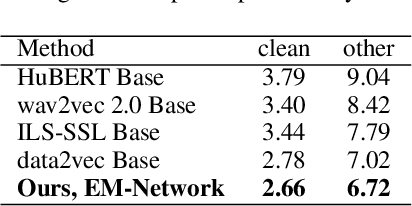
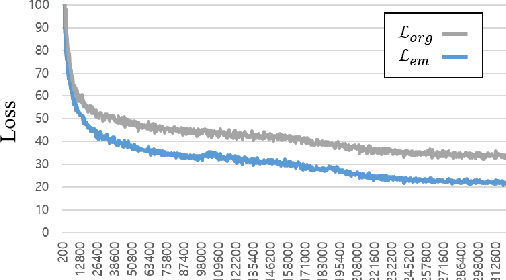
Abstract:We introduce EM-Network, a novel self-distillation approach that effectively leverages target information for supervised sequence-to-sequence (seq2seq) learning. In contrast to conventional methods, it is trained with oracle guidance, which is derived from the target sequence. Since the oracle guidance compactly represents the target-side context that can assist the sequence model in solving the task, the EM-Network achieves a better prediction compared to using only the source input. To allow the sequence model to inherit the promising capability of the EM-Network, we propose a new self-distillation strategy, where the original sequence model can benefit from the knowledge of the EM-Network in a one-stage manner. We conduct comprehensive experiments on two types of seq2seq models: connectionist temporal classification (CTC) for speech recognition and attention-based encoder-decoder (AED) for machine translation. Experimental results demonstrate that the EM-Network significantly advances the current state-of-the-art approaches, improving over the best prior work on speech recognition and establishing state-of-the-art performance on WMT'14 and IWSLT'14.
Inter-KD: Intermediate Knowledge Distillation for CTC-Based Automatic Speech Recognition
Nov 28, 2022Abstract:Recently, the advance in deep learning has brought a considerable improvement in the end-to-end speech recognition field, simplifying the traditional pipeline while producing promising results. Among the end-to-end models, the connectionist temporal classification (CTC)-based model has attracted research interest due to its non-autoregressive nature. However, such CTC models require a heavy computational cost to achieve outstanding performance. To mitigate the computational burden, we propose a simple yet effective knowledge distillation (KD) for the CTC framework, namely Inter-KD, that additionally transfers the teacher's knowledge to the intermediate CTC layers of the student network. From the experimental results on the LibriSpeech, we verify that the Inter-KD shows better achievements compared to the conventional KD methods. Without using any language model (LM) and data augmentation, Inter-KD improves the word error rate (WER) performance from 8.85 % to 6.30 % on the test-clean.
Oracle Teacher: Towards Better Knowledge Distillation
Nov 05, 2021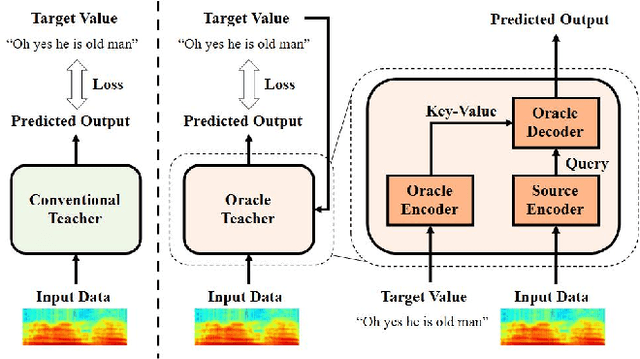
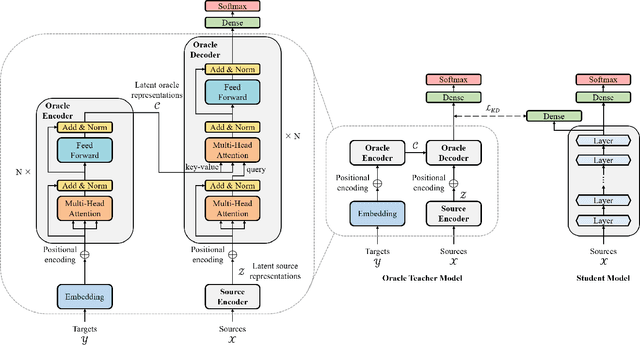
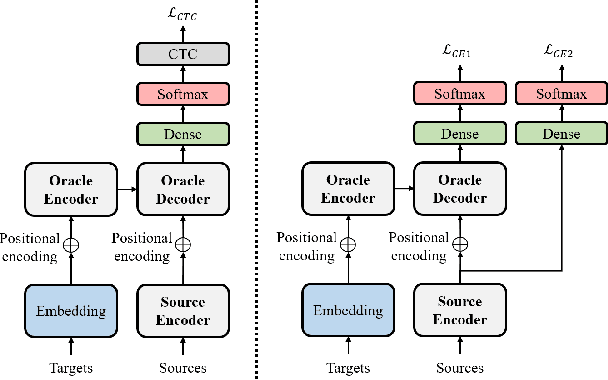
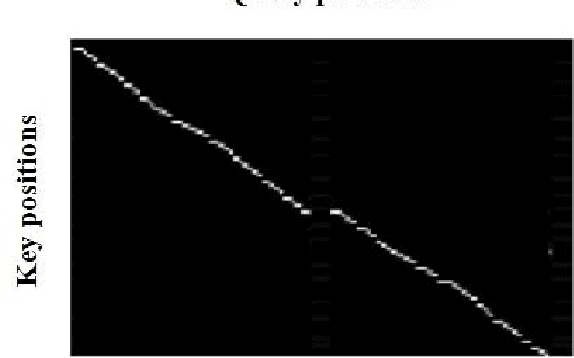
Abstract:Knowledge distillation (KD), best known as an effective method for model compression, aims at transferring the knowledge of a bigger network (teacher) to a much smaller network (student). Conventional KD methods usually employ the teacher model trained in a supervised manner, where output labels are treated only as targets. Extending this supervised scheme further, we introduce a new type of teacher model for KD, namely Oracle Teacher, that utilizes the embeddings of both the source inputs and the output labels to extract a more accurate knowledge to be transferred to the student. The proposed model follows the encoder-decoder attention structure of the Transformer network, which allows the model to attend to related information from the output labels. Extensive experiments are conducted on three different sequence learning tasks: speech recognition, scene text recognition, and machine translation. From the experimental results, we empirically show that the proposed model improves the students across these tasks while achieving a considerable speed-up in the teacher model's training time.
Continuous Monitoring of Blood Pressure with Evidential Regression
Feb 26, 2021


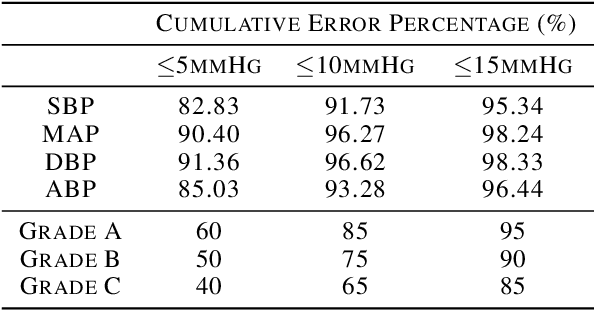
Abstract:Photoplethysmogram (PPG) signal-based blood pressure (BP) estimation is a promising candidate for modern BP measurements, as PPG signals can be easily obtained from wearable devices in a non-invasive manner, allowing quick BP measurement. However, the performance of existing machine learning-based BP measuring methods still fall behind some BP measurement guidelines and most of them provide only point estimates of systolic blood pressure (SBP) and diastolic blood pressure (DBP). In this paper, we present a cutting-edge method which is capable of continuously monitoring BP from the PPG signal and satisfies healthcare criteria such as the Association for the Advancement of Medical Instrumentation (AAMI) and the British Hypertension Society (BHS) standards. Furthermore, the proposed method provides the reliability of the predicted BP by estimating its uncertainty to help diagnose medical condition based on the model prediction. Experiments on the MIMIC II database verify the state-of-the-art performance of the proposed method under several metrics and its ability to accurately represent uncertainty in prediction.
WaveNODE: A Continuous Normalizing Flow for Speech Synthesis
Jul 02, 2020
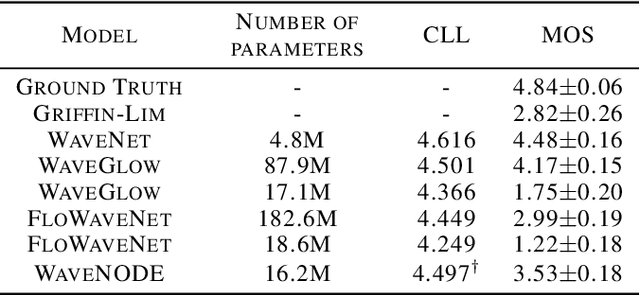
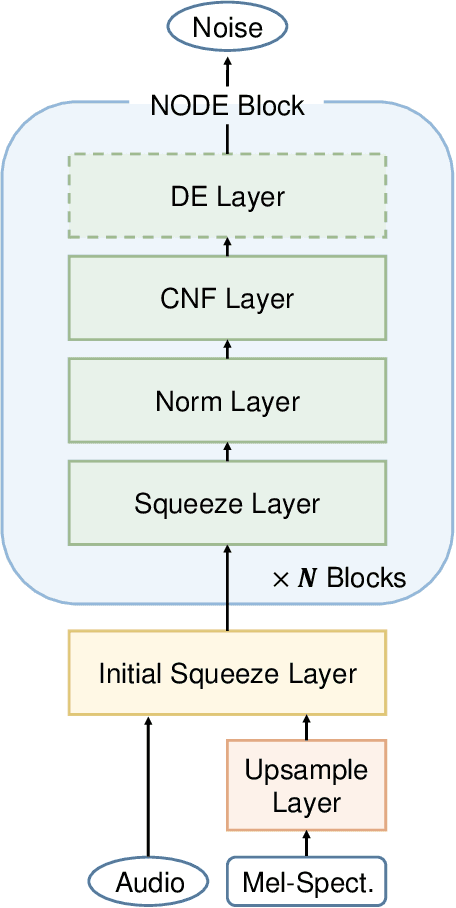
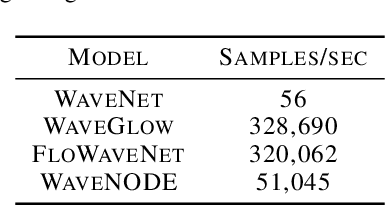
Abstract:In recent years, various flow-based generative models have been proposed to generate high-fidelity waveforms in real-time. However, these models require either a well-trained teacher network or a number of flow steps making them memory-inefficient. In this paper, we propose a novel generative model called WaveNODE which exploits a continuous normalizing flow for speech synthesis. Unlike the conventional models, WaveNODE places no constraint on the function used for flow operation, thus allowing the usage of more flexible and complex functions. Moreover, WaveNODE can be optimized to maximize the likelihood without requiring any teacher network or auxiliary loss terms. We experimentally show that WaveNODE achieves comparable performance with fewer parameters compared to the conventional flow-based vocoders.
SoftFlow: Probabilistic Framework for Normalizing Flow on Manifolds
Jun 09, 2020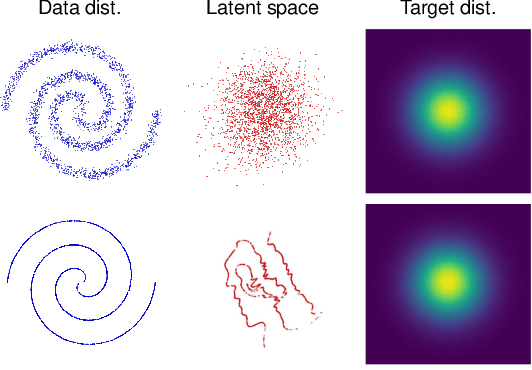
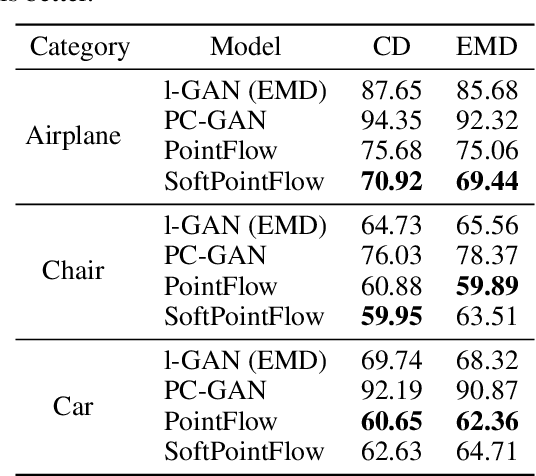
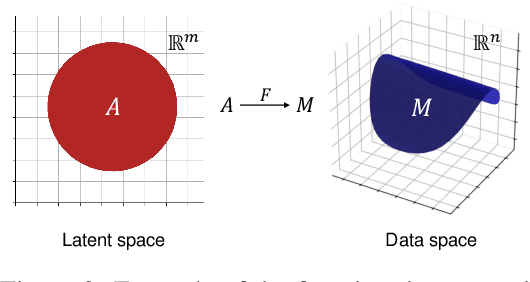
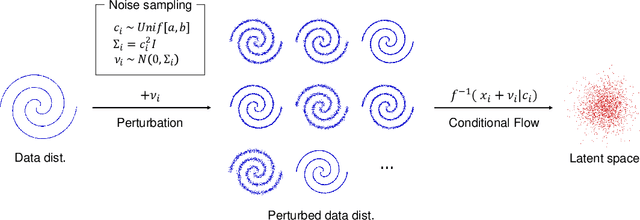
Abstract:Flow-based generative models are composed of invertible transformations between two random variables of the same dimension. Therefore, flow-based models cannot be adequately trained if the dimension of the data distribution does not match that of the underlying target distribution. In this paper, we propose SoftFlow, a probabilistic framework for training normalizing flows on manifolds. To sidestep the dimension mismatch problem, SoftFlow estimates a conditional distribution of the perturbed input data instead of learning the data distribution directly. We experimentally show that SoftFlow can capture the innate structure of the manifold data and generate high-quality samples unlike the conventional flow-based models. Furthermore, we apply the proposed framework to 3D point clouds to alleviate the difficulty of forming thin structures for flow-based models. The proposed model for 3D point clouds, namely SoftPointFlow, can estimate the distribution of various shapes more accurately and achieves state-of-the-art performance in point cloud generation.
 Add to Chrome
Add to Chrome Add to Firefox
Add to Firefox Add to Edge
Add to Edge